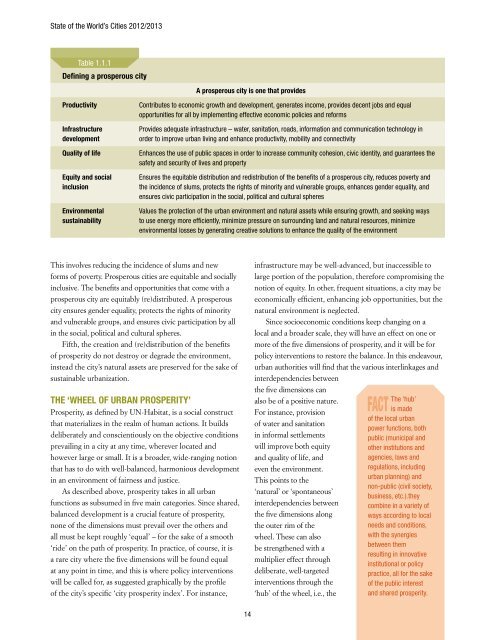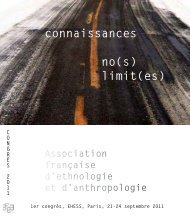state of the world's cities 2012/2013 - United Nations Sustainable ...
state of the world's cities 2012/2013 - United Nations Sustainable ...
state of the world's cities 2012/2013 - United Nations Sustainable ...
Create successful ePaper yourself
Turn your PDF publications into a flip-book with our unique Google optimized e-Paper software.
State <strong>of</strong> <strong>the</strong> World’s Cities <strong>2012</strong>/<strong>2013</strong>Table 1.1.1Defining a prosperous cityA prosperous city is one that providesProductivityInfrastructuredevelopmentQuality <strong>of</strong> lifeEquity and socialinclusionEnvironmentalsustainabilityContributes to economic growth and development, generates income, provides decent jobs and equalopportunities for all by implementing effective economic policies and reformsProvides adequate infrastructure – water, sanitation, roads, information and communication technology inorder to improve urban living and enhance productivity, mobility and connectivityEnhances <strong>the</strong> use <strong>of</strong> public spaces in order to increase community cohesion, civic identity, and guarantees <strong>the</strong>safety and security <strong>of</strong> lives and propertyEnsures <strong>the</strong> equitable distribution and redistribution <strong>of</strong> <strong>the</strong> benefits <strong>of</strong> a prosperous city, reduces poverty and<strong>the</strong> incidence <strong>of</strong> slums, protects <strong>the</strong> rights <strong>of</strong> minority and vulnerable groups, enhances gender equality, andensures civic participation in <strong>the</strong> social, political and cultural spheresValues <strong>the</strong> protection <strong>of</strong> <strong>the</strong> urban environment and natural assets while ensuring growth, and seeking waysto use energy more efficiently, minimize pressure on surrounding land and natural resources, minimizeenvironmental losses by generating creative solutions to enhance <strong>the</strong> quality <strong>of</strong> <strong>the</strong> environmentThis involves reducing <strong>the</strong> incidence <strong>of</strong> slums and newforms <strong>of</strong> poverty. Prosperous <strong>cities</strong> are equitable and sociallyinclusive. The benefits and opportunities that come with aprosperous city are equitably (re)distributed. A prosperouscity ensures gender equality, protects <strong>the</strong> rights <strong>of</strong> minorityand vulnerable groups, and ensures civic participation by allin <strong>the</strong> social, political and cultural spheres.Fifth, <strong>the</strong> creation and (re)distribution <strong>of</strong> <strong>the</strong> benefits<strong>of</strong> prosperity do not destroy or degrade <strong>the</strong> environment,instead <strong>the</strong> city’s natural assets are preserved for <strong>the</strong> sake <strong>of</strong>sustainable urbanization.The ‘Wheel <strong>of</strong> Urban Prosperity’Prosperity, as defined by UN-Habitat, is a social constructthat materializes in <strong>the</strong> realm <strong>of</strong> human actions. It buildsdeliberately and conscientiously on <strong>the</strong> objective conditionsprevailing in a city at any time, wherever located andhowever large or small. It is a broader, wide-ranging notionthat has to do with well-balanced, harmonious developmentin an environment <strong>of</strong> fairness and justice.As described above, prosperity takes in all urbanfunctions as subsumed in five main categories. Since shared,balanced development is a crucial feature <strong>of</strong> prosperity,none <strong>of</strong> <strong>the</strong> dimensions must prevail over <strong>the</strong> o<strong>the</strong>rs andall must be kept roughly ‘equal’ – for <strong>the</strong> sake <strong>of</strong> a smooth‘ride’ on <strong>the</strong> path <strong>of</strong> prosperity. In practice, <strong>of</strong> course, it isa rare city where <strong>the</strong> five dimensions will be found equalat any point in time, and this is where policy interventionswill be called for, as suggested graphically by <strong>the</strong> pr<strong>of</strong>ile<strong>of</strong> <strong>the</strong> city’s specific ‘city prosperity index’. For instance,infrastructure may be well-advanced, but inaccessible tolarge portion <strong>of</strong> <strong>the</strong> population, <strong>the</strong>refore compromising <strong>the</strong>notion <strong>of</strong> equity. In o<strong>the</strong>r, frequent situations, a city may beeconomically efficient, enhancing job opportunities, but <strong>the</strong>natural environment is neglected.Since socioeconomic conditions keep changing on alocal and a broader scale, <strong>the</strong>y will have an effect on one ormore <strong>of</strong> <strong>the</strong> five dimensions <strong>of</strong> prosperity, and it will be forpolicy interventions to restore <strong>the</strong> balance. In this endeavour,urban authorities will find that <strong>the</strong> various interlinkages andinterdependencies between<strong>the</strong> five dimensions canalso be <strong>of</strong> a positive nature.The ‘hub’For instance, provisionFACT is made<strong>of</strong> <strong>the</strong> local urban<strong>of</strong> water and sanitationpower functions, bothin informal settlementspublic (municipal andwill improve both equityo<strong>the</strong>r institutions andand quality <strong>of</strong> life, andagencies, laws andeven <strong>the</strong> environment.regulations, includingurban planning) andThis points to <strong>the</strong>non-public (civil society,‘natural’ or ‘spontaneous’business, etc.).<strong>the</strong>yinterdependencies between combine in a variety <strong>of</strong><strong>the</strong> five dimensions alongways according to local<strong>the</strong> outer rim <strong>of</strong> <strong>the</strong>needs and conditions,wheel. These can alsowith <strong>the</strong> synergiesbetween <strong>the</strong>mbe streng<strong>the</strong>ned with aresulting in innovativemultiplier effect throughinstitutional or policydeliberate, well-targetedpractice, all for <strong>the</strong> sakeinterventions through <strong>the</strong> <strong>of</strong> <strong>the</strong> public interest‘hub’ <strong>of</strong> <strong>the</strong> wheel, i.e., <strong>the</strong> and shared prosperity.14





